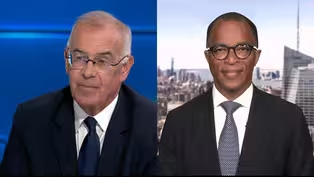
NTSB reveals details on mid-air collision that killed 67
Clip: 8/1/2025 | 4m 51sVideo has Closed Captions
What NTSB hearings revealed about the Washington mid-air collision that killed 67
The National Transportation Safety Board wrapped up a three-day investigative hearing into the mid-air collision between a helicopter and passenger jet in Washington that killed 67. New information confirms the crew of the Army helicopter faced several problems, including incorrect altitude measurements and issues hearing air traffic controllers. Aviation correspondent Miles O’Brien reports.
Problems playing video? | Closed Captioning Feedback
Problems playing video? | Closed Captioning Feedback
Major corporate funding for the PBS News Hour is provided by BDO, BNSF, Consumer Cellular, American Cruise Lines, and Raymond James. Funding for the PBS NewsHour Weekend is provided by...

NTSB reveals details on mid-air collision that killed 67
Clip: 8/1/2025 | 4m 51sVideo has Closed Captions
The National Transportation Safety Board wrapped up a three-day investigative hearing into the mid-air collision between a helicopter and passenger jet in Washington that killed 67. New information confirms the crew of the Army helicopter faced several problems, including incorrect altitude measurements and issues hearing air traffic controllers. Aviation correspondent Miles O’Brien reports.
Problems playing video? | Closed Captioning Feedback
How to Watch PBS News Hour
PBS News Hour is available to stream on pbs.org and the free PBS App, available on iPhone, Apple TV, Android TV, Android smartphones, Amazon Fire TV, Amazon Fire Tablet, Roku, Samsung Smart TV, and Vizio.
Providing Support for PBS.org
Learn Moreabout PBS online sponsorshipAMNA NAWAZ: The National Transportation Safety Board has wrapped up a three-day investigative hearing into the midair collision between a helicopter and a passenger jet in Washington, D.C., that killed 67 people back in January.
New information confirms the crew of the Black Hawk helicopter faced several problems, including incorrect altitude measurements and issues hearing air traffic controllers.
Aviation correspondent Miles O'Brien is here to unpack it all.
So, Miles, three days of public hearings.
Do we have a better understanding of what went wrong?
What stood out to you?
MILES O'BRIEN: We do, Amna.
One thing that stood out to me is, this was a very contentious NTSB hearing.
That normally doesn't occur that way.
And a lot of the focus and the ire was directed at the Federal Aviation Administration.
We have to begin with the fact, Amna, that the tower at Washington Reagan Airport was understaffed.
One controller was handling two frequencies, the fixed-wing airliner coming in for landing and the helicopter traffic designed to fly beneath that flight path.
That controller was overwhelmed.
And, as you pointed out, inside that darkened Army helicopter on a training mission, there was confusion on communication.
There was a little bit of confusion about what altitude they were at.
And, ultimately, when the controller said, do you see the airliner, they looked at apparently another aircraft and said, yes, we do.
But it wasn't the aircraft that they ultimately collided with.
So, a series of confusing events, and ultimately, at the root of it, an overwhelmed flight controller who was handling two frequencies where two people should have been assigned.
AMNA NAWAZ: And, Miles, as we know, the families of the victims were attending the hearings.
They were hearing all of these details.
It had to be difficult for them.
But they also heard Jennifer Homendy, who's the NTSB chair, criticize the FAA, the Federal Aviation Administration, for not taking ownership of the collision, she said, and also said the agency ignored warnings after one of their towers had flagged a safety risk.
Take a listen.
JENNIFER HOMENDY, Chair, National Transportation Safety Board: But you guys are pointing out, well, our bureaucratic process, somebody should have brought it up at some other symposium.
Are you kidding me?
Sixty-seven people are dead.
How do you explain that?
Our bureaucratic process?
Do you know we actually added up how many steps it takes to get from the tower to headquarters to figure out - - and we ran all sorts of scenarios, how many steps it takes to get a policy change.
Twenty-one steps.
Fix it.
Do better.
AMNA NAWAZ: So, Miles, what was and what should be the FAA role here?
MILES O'BRIEN: Yes, 21 steps, bureaucratic inertia, to say the least, and ultimately costing a lot of lives.
Amna, this architecture of airspace in Washington for years was an area of great concern.
To have helicopters fly beneath that flight path with only 75 feet margin of error was clearly a safety issue, and yet the FAA for years did nothing about it.
Amna, over the past three years, there were no less than 85 near-collisions in that sector.
And that is a system blinking red, and the FAA did nothing.
AMNA NAWAZ: Miles, I have to ask you, because folks will have seen a number of other headlines about airline travel, one severe turbulence on a Delta flight in which a number of people were injured, another close call over North Dakota between a B-52 bomber and a Delta jet.
Is it still safe to fly?
MILES O'BRIEN: Statistically, it is.
It's still the safest way to get from point A to point B.
But we are seeing the system developing stress fractures, Amna.
The understaffing, the bureaucratic inertia, the safety redundancies built into this system are being shaved away.
And this accident we have just been talking about, this midair, is a warning call that the system is in trouble and it's time to invest in the people, the personnel and the technology to modernize this system and take these serious safety concerns much more seriously.
For years, Amna, people in the aviation world have said the FAA has a tombstone mentality.
Unfortunately, that's what we're seeing here.
And it's time that changed.
AMNA NAWAZ: Miles O'Brien, thank you, as always, for your time.
MILES O'BRIEN: You're welcome, Amna.
Brooks and Capehart on Trump's firing of jobs report chief
Video has Closed Captions
Clip: 8/1/2025 | 11m 5s | Brooks and Capehart on Trump's firing of labor statistics head after weak jobs report (11m 5s)
News Wrap: Federal Reserve governor to resign early
Video has Closed Captions
Clip: 8/1/2025 | 6m 15s | News Wrap: Federal Reserve governor to resign early, giving Trump an opening to fill (6m 15s)
Renowned Pakistani filmmaker on fighting gender inequality
Video has Closed Captions
Clip: 8/1/2025 | 3m 49s | Renowned Pakistani filmmaker on fighting gender inequality (3m 49s)
Tariffs will help improve 'broken' global economy, Cass says
Video has Closed Captions
Clip: 8/1/2025 | 8m 32s | Tariffs will help improve 'broken global economic situation,' economist Oren Cass says (8m 32s)
Trump's effort to reshape the White House in his image
Video has Closed Captions
Clip: 8/1/2025 | 4m 31s | A look at Trump's effort to reshape the White House in his image (4m 31s)
U.S. whistleblower describes what he saw at Gaza aid sites
Video has Closed Captions
Clip: 8/1/2025 | 13m 23s | Security contractor says he witnessed ‘barbaric’ and un-American tactics at Gaza aid sites (13m 23s)
Providing Support for PBS.org
Learn Moreabout PBS online sponsorshipSupport for PBS provided by:
Major corporate funding for the PBS News Hour is provided by BDO, BNSF, Consumer Cellular, American Cruise Lines, and Raymond James. Funding for the PBS NewsHour Weekend is provided by...

















